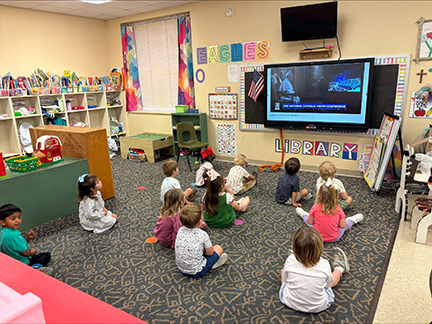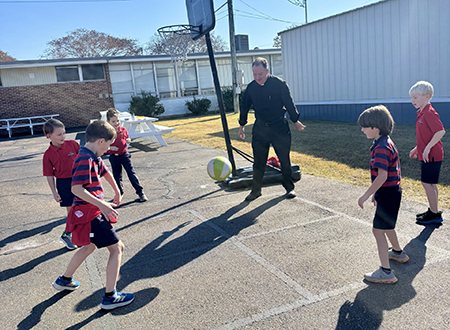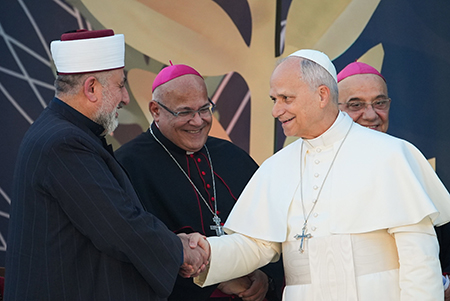
By Galen Holley
NEW ALBANY – Luis, de siete años, tenía el aspecto perfecto, con su bigote dibujado y su tilma holgada, y al verlo junto a sus padres, uno podía imaginar a Juan Diego devorando una galleta antes de la misa, tal como lo hacía Luis. La gloria y la pompa de la fiesta de Nuestra Señora de Guadalupe resplandecían en una fría noche en New Albany.
“Sentimos que nuestros corazones arden de gratitud hacia Nuestra Señora”, dijo Alma Solís, quien, el 12 de diciembre, se afanaba en el santuario organizando la celebración. Solís, una voluntaria incansable, dirigía a los monaguillos, daba indicaciones a los bailarines y traducía sobre la marcha del inglés al español.
“La celebración es importante para los católicos y especialmente para los mexicanos”, dijo Solís, cuyo suegro, Pablo García, a pesar de la barrera del idioma, se está formando para convertirse en diácono.
Los padres de la comunidad hispana habían vestido a sus hijos pequeños como el santo campesino Juan Diego, el sencillo indígena a quien, en 1531, se le apareció María, la Madre de Dios. Nuestra Señora visitó a Juan Diego en el cerro del Tepeyac, en lo que hoy es la Ciudad de México. Amonestó al pueblo para que abandonara las prácticas paganas y ofreció señales milagrosas como prueba del amor de Jesús. María, por el poder de Dios, hizo florecer rosas en invierno en el cerro del Tepeyac, y desde entonces el catolicismo floreció en América Latina.
Los católicos construyeron una iglesia en el lugar de la aparición en el siglo XVI, y hoy en día es uno de los destinos más visitados de todo el mundo cristiano. Sin embargo, como dijo el párroco de San Francisco, el padre Xavier Jesuraj, en su homilía del 12 de diciembre, la basílica representa algo más profundo.

“La construcción de la iglesia no era lo más importante para la Santísima Madre”, dijo el padre Raj.
“La Virgen estaba presente no solo como un signo externo, sino como una promesa de que ella está con nosotros en nuestras alegrías y tristezas, en todos los momentos y aspectos de nuestras vidas. Ella nos anima a ofrecer nuestras vidas cotidianas como una devoción y una continuación de la celebración en la que participamos esta noche”.
La imagen de Nuestra Señora de Guadalupe se ha convertido en el símbolo de fe más popular entre los católicos mexicanos. La aparición inculturada de María, con piel morena y cabello oscuro, contrasta fuertemente con las imágenes europeas de la Santísima Madre y sugiere su carácter universal como Madre de la Iglesia. Como dijo el padre Raj: “Ella vino como una señal no solo para América Latina, sino también para Europa y todo el mundo, proclamando el amor de su hijo, Jesús”.
Los bigotes dibujados en los labios de los bebés en San Francisco eran una adorable señal de lo mucho que significa la fiesta de Nuestra Señora de Guadalupe para los católicos hispanos. La visión de los beatificados liliputienses tambaleándose en el santuario, vestidos con sus trajes campesinos y con sombreros de paja en la mano, era suficiente para inspirar deleite religioso.

La parroquia de San Francisco celebró recientemente su septuagésimo quinto aniversario y, como cada 12 de diciembre, la iglesia estaba abarrotada. La pequeña Kaitlyn Melany colocó con cariño, aunque tímidamente, un ramo de flores ante la estatua de Nuestra Señora. Ulysses Sánchez, de un año, dormía angelicalmente en brazos de su madre, vestido con su traje de Juan Diego, de color rojo y verde. Katherine y su hermana pequeña, Melanie, iban vestidas como Nuestra Señora y parecían disfrutar del espectáculo y la energía de la congregación.
Afuera, los miembros del grupo de baile de la iglesia católica St. Matthew en Ripley, entre ellos Emily Juárez, Sandy Ruiz Martinze y Giovanni Martínez, se movían al ritmo de los golpes del tambor. Los fieles cantaban himnos a Nuestra Señora, dando gracias por su intercesión y sus oraciones, y luego disfrutaban de una suntuosa comida mientras los niños correteaban con sonrisas y gritos de alegría.
(Galen Holley es miembro de la parroquia de San Francisco de Asís en New Albany. Puedes contactarlo en galenholley@gmail.com y ver su “Podcast de San Miguel” en YouTube).














